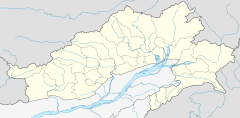| Nyamjang Chu | |
|---|---|
| Location | |
| Country | China; India |
| Region/State | Shannan, Tibet; Arunachal Pradesh |
| District | Tsona County; Tawang district |
| Cities/Circles | Qudromo, Jiba, Gongri, Marmang, Lai; Zemithang, Dudunghar |
| Physical characteristics | |
| Source | Eastern Himalayas |
| • location | Tsona County |
| • coordinates | 28°25′47″N 91°51′35″E / 28.4297°N 91.8596°E |
| • elevation | 5,400 m (17,700 ft) |
| Mouth | Tawang Chu |
• location | Lumla Circle |
• coordinates | 27°29′56″N 91°41′06″E / 27.499°N 91.685°E |
• elevation | 1,040 m (3,410 ft) |
| Length | 125 kilometres (78 mi) |
| Basin size | 3,170 square kilometres (1,220 sq mi)[1] |
| Discharge | |
| • location | Zemithang |
| • average | 3,400 cubic metres (120,000 cu ft) per second |
| Basin features | |
| Progression | Tawang Chu, Manas River |
| River system | Brahmaputra |
The Nyamjang Chu,[2] or Nyashang Chu[3] (Tibetan: ཉ་བཤང་ཆུ, Wylie: nya bshang chu, THL: nya shang chu)[4][a] is a cross-border perennial river that originates in the Shannan Prefecture of Tibet and flows into the Arunachal Pradesh state of India, joining the Tawang Chu river just before it enters Bhutan. The Nyamjang Chu valley has provided the traditional communication route between Tawang and Tibet. The valley near the town of Zemithang in the Tawang district, called the Pangchen Valley, is known for its serene beauty and forms one of the wintering locations for the black-necked crane.
The China–India border in the valley has been contested between the two countries since the 1950s, resulting in a clash at the Namka Chu in 1962 and a standoff at the Sumdorong Chu in 1986.
- ^ NJC Hydropower Limited (2017), p. 4-1.
- ^ Bailey, Exploration on the North-East Frontier (1914), p. 16.
- ^ Dorje, Footprint Tibet (1999), p. 200.
- ^ "Geographical names of Tibet AR (China): Tibet Autonomous Region". KNAB Place Name Database. Institute of the Estonian Language. 3 June 2018.
Cite error: There are <ref group=lower-alpha> tags or {{efn}} templates on this page, but the references will not show without a {{reflist|group=lower-alpha}} template or {{notelist}} template (see the help page).

